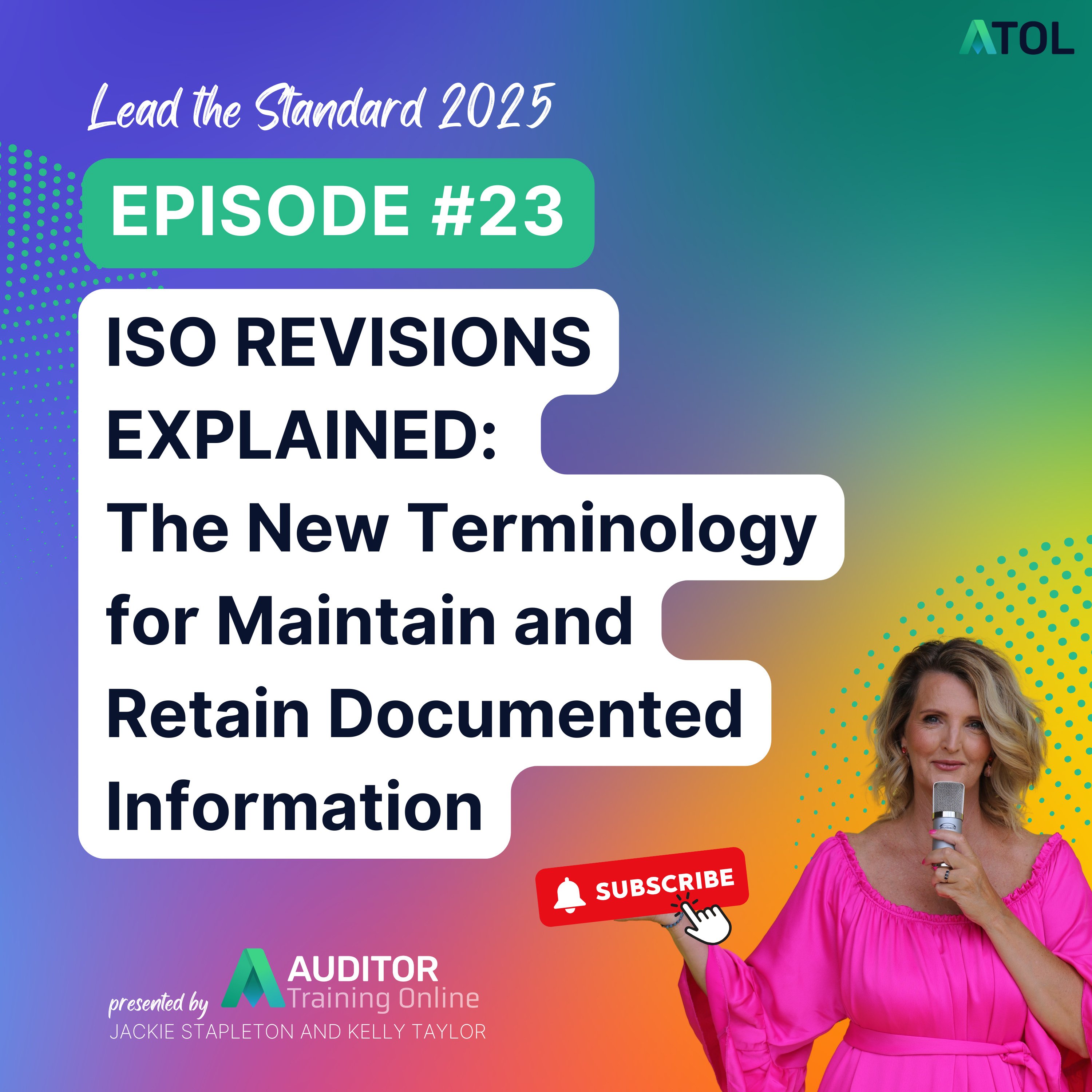ISO Revisions Explained
Management Systems • 25 September 2025 6:00:00 AM • Author: Jackie Stapleton

ISO Revisions: The New Terminology for Maintain and Retain Documented Information
Over the years, I’ve explained the difference between maintain documented information and retain documented information more times than I can count. Clients, students, teams—everyone has struggled with it at some point.
I had my go-to way of making it simple:
-
Maintain = procedures, the how-to
-
Retain = keep evidence and records
That explanation has served us well. Until now.
Because the terminology is changing in the upcoming standard revisions. And it’s changed to the point where I can’t even remember the new wording myself. I’ve literally got a post-it note stuck to my monitor just to remind me of the upcoming new terms.
So, after all these years of drilling “maintain vs. retain,” you can forget it. It’s all about to change.
But terminology—whatever ISO calls it—doesn’t change the core reality: clear, consistent documentation matters. Procedures, records, “things we maintain,” “things we retain”—however you label them, good documentation is non-negotiable.

Documentation isn’t just an ISO requirement—it’s smart business. When knowledge only lives in someone’s head, it disappears the moment they leave the room (or the company). A solid documentation culture protects against that loss, saves hours of interruptions, and makes sure critical know-how is always available.
Forbes summed this up well in their article To Scale Your Company’s Knowledge, Build a Documentation Culture, which shows how businesses that embed documentation into daily practice free up time, reduce risk, and grow faster.

AI Management Systems Specialist (ISO 42001)
AU$1,195.00Step into the future of responsible AI with the ISO 42001 Specialist Course. This program equips you to design, implement, and manage an Artificial Intelligence Management System (AIMS) in line with ISO/IEC 42001:2023, the world’s first certifiable AI governance standard.
ISO Documentation Naming Conventions Cheat Sheet
The new wording can feel a little clunky (and long!), so I’ve broken it down into a simple reference. Think of this as a quick memory aid—something you can come back to when you’re not sure which term is which.
.png?width=1920&height=1080&name=LTS%20DIAGRAM%2023%20(1).png)
Old vs New
We used to talk about “maintain” and “retain.” The new wording shifts to “made available” and “available as evidence.” Different words, but the same idea: documents people use versus records you keep.
Meaning
If it’s something people need to follow—like a procedure or an instruction—then it falls into the “made available” category. If it’s something you keep as proof—like an audit report or a training record—then it’s “available as evidence.”
Examples
Procedures and flowcharts are your how-to guides—make them available. Completed forms and audit reports? That’s proof—keep them as evidence.
Easy Way to Remember
If it’s something people need to use to do the job, it goes under “maintain/made available.” If it’s something you keep as evidence the job was done, it goes under “retain/available as evidence.”
Quick test: Use it or show it?
- Use it = make available
- Show it = evidence
Helping People Transition
Don’t worry — you don’t need to rush out and update every manual, policy, or procedure just because the words are changing. ISO doesn’t mandate that you copy the exact wording. You can still call it “maintain” and “retain” in your system if that makes sense for your people.
What matters is how you, as a leader, help your team understand the shift. A few tips:
- Explain the change simply — share the idea of “use vs show” so people aren’t caught up in the jargon.
- Reassure them — remind everyone that the principles haven’t changed, only the labels.
- Update training and conversations, not documents — weave the new terms into toolbox talks, inductions, or management reviews so people get used to hearing them.
- Lead by example — use the new terms yourself, but don’t correct others harshly. Encourage, explain, and move on.
By doing this, you keep the system practical and your people confident — which is exactly what leadership in ISO is all about.
/27001%20Intro.jpg?width=700&name=27001%20Intro.jpg)
Introduction to ISO 27001:2022 Information Security Management Systems
AU$549.00This short, fully online course provides a clear, beginner-friendly introduction to ISO 27001:2022 and its role in information security management. This course is designed for anyone who needs a high-level understanding of ISO 27001 without getting into technical details or formal assessments.
Next Steps for You
- Check your own system
Are your documents clear on what’s for use and what’s for evidence? - Share the update
Let your team know about the wording change and explain it in simple terms. - Pick your wording
Decide what makes sense for your organization and stick with it. - Use memory hooks
"Use it or show it" works just as well with the new terms. - Stay flexible
Don’t get hung up on the wording, focus on keeping documentation practical and useful.
For more on this topic, listen to the podcast...

From Information to Certification

